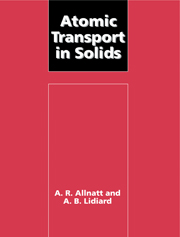Book contents
- Frontmatter
- Contents
- Preface
- List of principal symbols
- 1 Atomic movements in solids – phenomenological equations
- 2 Imperfections in solids
- 3 Statistical thermodynamics of crystals containing point defects
- 4 Non-equilibrium thermodynamics of atomic transport processes in solids
- 5 Some applications of non-equilibrium thermodynamics to solids
- 6 Microscopic theories – the master equation
- 7 Kinetic theory of relaxation processes
- 8 Kinetic theory of isothermal diffusion processes
- 9 The theory of random walks
- 10 Random-walk theories of atomic diffusion
- 11 Transport coefficients of dilute solid solutions – results and applications
- 12 The evaluation of nuclear magnetic relaxation rates
- 13 Theories of concentrated and highly defective systems
- References
- Index
6 - Microscopic theories – the master equation
Published online by Cambridge University Press: 28 December 2009
- Frontmatter
- Contents
- Preface
- List of principal symbols
- 1 Atomic movements in solids – phenomenological equations
- 2 Imperfections in solids
- 3 Statistical thermodynamics of crystals containing point defects
- 4 Non-equilibrium thermodynamics of atomic transport processes in solids
- 5 Some applications of non-equilibrium thermodynamics to solids
- 6 Microscopic theories – the master equation
- 7 Kinetic theory of relaxation processes
- 8 Kinetic theory of isothermal diffusion processes
- 9 The theory of random walks
- 10 Random-walk theories of atomic diffusion
- 11 Transport coefficients of dilute solid solutions – results and applications
- 12 The evaluation of nuclear magnetic relaxation rates
- 13 Theories of concentrated and highly defective systems
- References
- Index
Summary
Introduction
In this and following chapters we shall consider those theories which are based on microscopic models of atomic movements and which allow us to obtain expressions for the macroscopic phenomenological coefficients introduced in the preceding two chapters. The principle on which all these particular models are founded has already been introduced in §§2.3 and 3.11 and is that the motion of atoms (or ions) of the solid may be divided into (i) thermal vibrations about defined lattice sites and (ii) displacements or ‘jumps’ from one such site to another, the mean time of stay of an atom on any one site being many times both the lattice vibration period and the time of flight between sites. The justification of this principle is provided widely in solid state physics. In general terms it derives from the strong cohesion of solids and the associated strong binding of atoms to their assigned lattice sites. This leads to well-defined phonon spectra such as have now been observed, especially by neutron scattering methods, in a wide range of solids. Theories of solid structures also show that there are generally large energy barriers standing in the way of the displacement of atoms from one site to another, even in the presence of imperfections in the structure, with the consequence that such displacements must be thermally activated and will occur relatively infrequently compared to the period of vibrational motions. Thus even the highest diffusion rates (say D ∼ 10−9m2 s−1) correspond to a mean time of stay τ ∼ 10−11 s, i.e. 100 times longer than the period of the lattice vibrations. It is more difficult to obtain information about the time …
- Type
- Chapter
- Information
- Atomic Transport in Solids , pp. 216 - 246Publisher: Cambridge University PressPrint publication year: 1993
- 1
- Cited by



